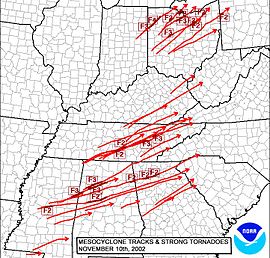2002 Veterans Day Weekend tornado outbreak

Veterans Day Tornado Outbreak
|
|
| Type | Tornado outbreak |
|---|---|
| Duration | November 9–11, 2002 |
| Tornadoes confirmed | 83 confirmed |
| Max rating1 | F4 Van Wert Co., OH tornado |
| Duration of tornado outbreak2 | ~36 hours, majority of the tornadoes occurred on November 10, 2002 |
| Damage | $160+ million |
| Casualties | 36 fatalities, 240+ injuries |
| Areas affected | Eastern United States (especially the Southeast and Ohio Valley. |
|
1Most severe tornado damage; see Fujita scale 2Time from first tornado to last tornado |
|
1Most severe tornado damage; see Fujita scale
The 2002 Veterans Day Weekend tornado outbreak was a large, widespread and rare outbreak of storms that occurred from the late afternoon hours on November 9 through the early morning hours on Veterans Day, November 11, 2002. Eighty-three tornadoes hit 17 states. Twelve tornadoes killed 36 people in five states. This ranks as the second biggest outbreak ever recorded in November.
The lower Ohio Valley and the South have two tornado seasons, one in the spring and a less intense and more sporadic one in autumn. The states in these regions are truly unique as they are the only places in the entire world with two distinct tornado seasons. During the autumn season, the upper atmospheric dynamics are once again more often conducive for major tornado outbreaks. Upper atmospheric temperatures cool down as the calendar shifts towards winter and jet stream winds increase, as does intensity of low pressure systems. Some of the most destructive severe weather events in USA history have occurred during the secondary season. Unfortunately, many people are not well aware of this secondary season as they are the spring season which can lead to a higher chance of people being caught off guard by severe weather. Many local national weather service offices in the south conduct storm spotter training sessions in the fall and even observe a fall severe weather awareness day in effort to draw more attention to this secondary peak.
The outbreak began in Arkansas in the late afternoon hours on Saturday, November 9, 2002. However, the brunt of the outbreak was on November 10. It began around 2 P.M. in Indiana and became widespread from Mississippi up through Ohio in the afternoon. Seventeen died in Tennessee, twelve in Alabama, five in Ohio, and one each in Pennsylvania and Mississippi.
The most notable and photogenic tornado of the outbreak was the one that occurred at Van Wert, Ohio. Van Wert has been hit before. The last time they were severely hit was during the 1920 Palm Sunday tornado outbreak. That tornado was an F4. During this tornado (which was also an F4), a theater was destroyed at around 3:30 P.M. The walls and roof were damaged or destroyed by the tornado and three cars were thrown into the front seats which minutes earlier had been completely filled with people. This was the farthest north and east such an intense tornado has occurred that late in the year. Notably, no one was killed at the packed theater because the manager received warning via Van Wert County Emergency Director Rick McCoy and evacuated everyone to the back theater. The lead time of this tornado was approximately 28 minutes. A tornado warning went out for Van Wert County at 3:02 P.M. This tornado outbreak was particularly noted because of the massive lead times on all the tornadoes, but there was a slight dispute because the northern tornadoes (such as Van Wert) occurred in severe thunderstorm watch boxes.
...
Wikipedia
